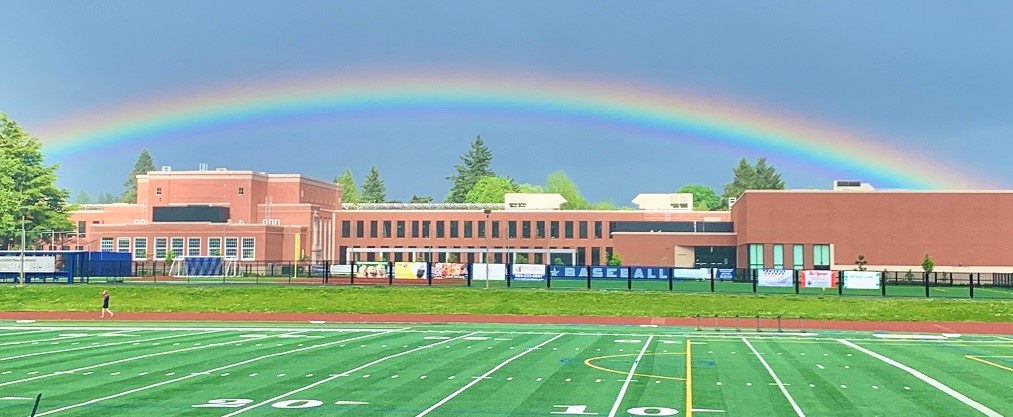
Grant High School gives presentation showing “Pyramid of White Supremacy”; school district promotes gender transitioning material to children
Incidents
Grant High School is pushing race and equity onto students and educators with the “Race Forward” project. In December 2021, the high school used a “Race Forward” presentation to teach students about equity. The presentation explains the meaning of the terms “whiteness,” “white fragility,” “white tears,” and “white saviorism.” The definitions appear to be derogatory against people who are considered “white”:
- Whiteness: Whiteness is defined by characteristics and experiences associated with being white, and it is connected to the belief that white people are the standard in society.
- White Fragility: When confronted by information about racism, white people demonstrate discomfort and defensiveness.
- i.e. a white person is called out for being racist and they establish their proximity to people of color while distancing themselves from whiteness. For example, bringing up having family members or friends who are Black.
- i.e. a white person is called out for being racist and they establish their proximity to people of color while distancing themselves from whiteness. For example, bringing up having family members or friends who are Black.
- White Tears: White tears appear in response to confrontation regarding race, shifting focus to and victimizing the white experience. i.e. this weaponization occurs against Black men and women in particular.
- For example, Kyle Rittenhouse crying during his homicide trial. In this situation, he expected comfort and accommodation from others.
- For example, Kyle Rittenhouse crying during his homicide trial. In this situation, he expected comfort and accommodation from others.
- White Saviorism: A white savior seeks praise while alienating the people they claim to help through performative or self-serving actions. This causes harm, intentional or not, by implying that white people are superior and must “save” the inferior people of color.
- i.e. The Blind Side, Freedom Writers
- In both of these films, a white woman comes to the “rescue” of young Black people and is made out to be a hero.
- i.e. The Blind Side, Freedom Writers
The presentation also features a “Privilege for Sale” game where a “privilege sheet” and “money” are provided. Participants then choose what privileges they want to purchase. The presentation then asks participants if they are “used to thinking about your identity in this way.”
The presentation later features a “Pyramid of White Supremacy” that starts with “indifference” at the bottom and goes to “genocide” at the top. Phrases like “remaining apolitical” and “two sides to every story” are located in the “indifference” category at the bottom. A category near the middle called “veiled racism” has phrases like “claiming reverse racism” and “cultural appropriation.” At the top is “genocide” with the phrase “mass murder.”
The presentation ends with the discussion of white supremacy. The presentation states that white supremacy is “systemic” and is “embedded in all of our institutions; political, economic, social, cultural, legal, military, educational, and more.” The presentation further explains that “not understanding that racism is institutional ensures that it will continue.”
Grant High School’s website features videos on its “Race Forward” page promoting the discussion of race. One video simply titled “Racism” lists that racism is “history,” “whiteness,” “building a wall,” “Donald Trump,” and “fetishization.” The videos appear to heavily involve students regarding the discussion of racism and what racism is.
On July 15, 2020, Grant High School published a news article on its website stating that Portland Public Schools plans to change the names of the school district’s buildings. The article mentions that the school district’s “Senior Advisor on Racial Equity and Social Justice” worked with the superintendent to create a plan to change building names. “Among the phases is a review and study of renaming Wilson High School, which is being undertaken because the former president it is named for expressed outright racist beliefs,” the article states.
The news article included a document from Portland Public Schools explaining the procedure to rename buildings. This process involves establishing a “Renaming and Redefining Committee” that will utilize a “Racial Equity Design Process.” This document includes links to a Racial Equity and Social Justice “Framework and Plan” and “Professional Development Framework.”
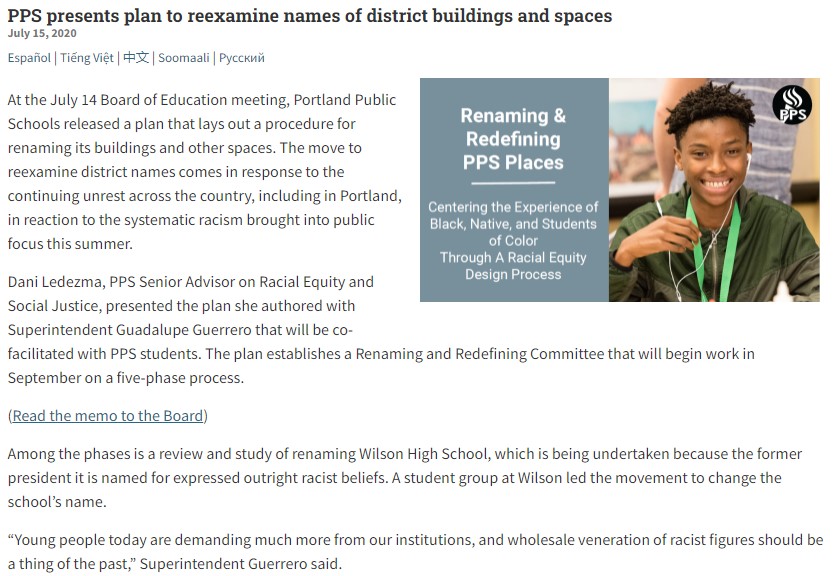
The “Framework and Plan” document states “that generating an equitable world requires an educational system that intentionally disrupts—and builds leaders to disrupt— systems of oppression.” Goals of this plan include “implementing a comprehensive, rigorous, and culturally responsive and sustaining core instructional program” and implementing “ethnic studies” into the school district’s curriculum. Goals also include developing “comprehensive resource allocation framework in alignment with racial equity and social justice” and increasing “opportunities for students to develop a positive social identity and develop language and historical and cultural knowledge that affirms and accurately describes their multifaceted identity.”
In the “Professional Development Framework” document, Portland Public Schools outright states its intention to implement Critical Race Theory (CRT). The document lists four “Racial Equity and Social Justice Professional Development Competencies.” CRT is mentioned in two of the four points:
- Identity
- Knowledge and comprehension of critical race theory and its application to racial equity and social justice in education.
- Understanding of personal identity and ability to analyze and evaluate personal relationship to power, privilege and oppression in education.
- Knowledge, comprehension and application of practices for positive cultural identity development.
- Knowledge and comprehension of intersectionality and the multidimensionality of oppressions.
- Ability to analyze and evaluate one’s own actions and decision making and system structures to identify root causes of institutional racism and oppression.
- Culturally Responsive Organization and Practices
- Knowledge and comprehension of foundations of culturally responsive practices and pedagogy.
- Knowledge and comprehension of the history, assets and issues of racial and ethnic groups in Portland.
- Knowledge and comprehension of developmentally, racially and culturally responsive practices and strategies with students and families related to gender identity, sexual orientation, and gender expression.
- Ability to analyze and evaluate current practices and system structures to identify barriers, challenges and opportunities for the application of culturally responsive practices.
- Implementing Strategies for Student Success – Closing the Opportunity Gap
- Ability to integrate understanding of critical race theory, positive intersectional identity development and culturally responsive practices and pedagogy into daily professional life to advance racial equity and social justice.
- Ability to identify and apply high leverage RESJ driven practices to accelerate student, school, and organizational outcomes.
- Ability to integrate culturally responsive and gender-inclusive practices into strategies to increase student success.
- Polices and practices reflect research and evidence based, culturally responsive practices to improve outcomes across student groups.
- Problems of Practice
- Ability to identify, analyze and evaluate practices, policies and structures that need adjustment/correction to achieve RESJ outcomes.
- Ability to engage in professional dialogue and collaboration with colleagues to address deeply entrenched issues.
- Ability to extend and refine knowledge and practices in cycles of improvement.
On October 7, 2021, Grant High School published an article stating that Portland Public Schools received an $8.2 million grant to build an “equity-centered principal pipeline.” The article states that Portland Public Schools “is one of eight U.S. school districts chosen to receive an $8.2 million, five-year grant from the Wallace Foundation to build an equity-centered pipeline for hiring and training principals.” The article further explains that the grant will assist “in further accelerating progress on its racial equity and social justice commitments to students and the larger PPS community.”
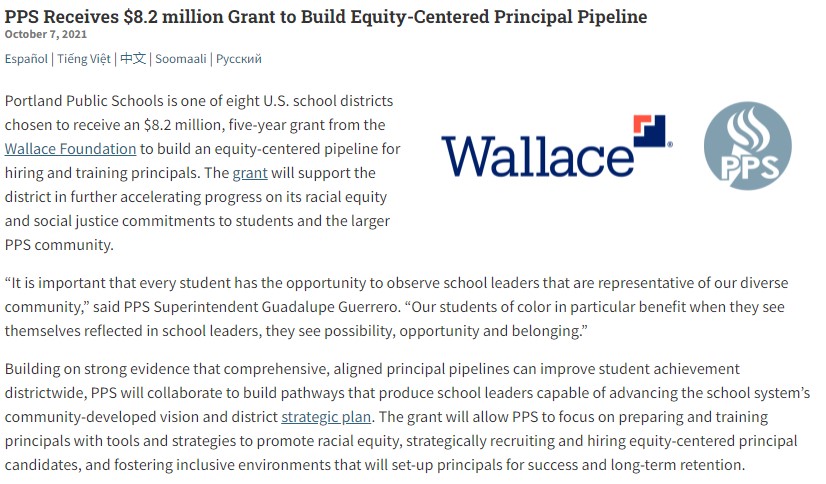
The grant article includes a link to a Portland Public Schools document called “Forward Together: 2021-2025 Strategic Plan for Racial Equity, Inclusion, and Excellence.” The document has imagery for political causes throughout it, specifically in support of Black Lives Matter. The plan has themes and outcomes that the school district supports achieving. One theme is focused on “Racial Equity and Social Justice.” The school district states that “we have to attack racism and longstanding, structural inequities in our system.” This includes establishing “a Center for Black Student Excellence, a constellation of built environments and a designated set of culturally responsive strategies that celebrate and advance Black student achievement.”
Portland Public Schools has a “Racial Equity and Social Justice” department promoted on its website. In a document titled “PPS Racial Equity and Social Justice Lens,” the school district states that it adopted a “Portland Public Schools reImagined” initiative. The initiative’s document appears to insinuate that the school district intends to build students up as political activists:
As racial equity leaders, students take part in making our society more just and equitable for people of color. They understand how our communities have been impacted by racial injustice, and they can recognize and interrupt the conditions that enable it. They develop agency and advocacy skills to challenge injustice and change oppressive systems in their communities. They understand that the dominant historical narrative can minimize the perspectives of people of color and contribute to institutional racism. They can deconstruct the dominant narrative and change it to a more balanced and inclusive one.
One June 13, 2011, Portland Public Schools approved a “Racial Educational Equity Policy” to implement equity across the school district. The policy states that “the concept of educational equity goes beyond formal equality — where all students are treated the same — to fostering a barrier-free environment where all students, regardless of their race, have the opportunity to benefit equally.” The policy further explains that “to achieve educational equity, PPS will provide additional and differentiated resources to support the success of all students, including students of color.”
Portland Public Schools offers resources for the local area’s population of illegal aliens. These resources include a presentation explaining what a sanctuary jurisdiction is, a document to show where immigration enforcement will not occur, and a “post-election support” document.
Portland Public Schools also has a “Climate Justice” department. The goal of the department is “to develop transdisciplinary curriculum and professional learning that empowers educators and youth to become transformative racial equity leaders and global stewards and ambassadors.” The school district continues to explain that the department intends to “support the development of K-12 science and social studies curriculum that engages students in learning about climate change and climate justice.”

The school district provides a document for staff for “LGBTQ Issues.” If students question their sexual orientation, the school district explains to staff that the information will not be provided to parents. The school district also provides guidance for teachers considering to transition to the opposite gender.
Assure the student that you realize this was told to you in confidence. Indicate that you won’t tell anyone–even their parents or guardians—unless (a) the student gives you permission (b) the student asks you for help that would require you to share this information or (c) you believe the student’s safety is at risk. Keep that promise. In the case of (c), the educator should discuss the safety concern with the principal to determine next steps.
Portland Public Schools has a “LGBTQ Resources for Students” page with resources aimed at children. One resource is referred to as the “Sexual & Gender Minority Youth Resource Center.” The school district states that the organization “offers a variety of support groups, services, and referrals, including a support group for trans-identified youth ages 14-23.” The school district also offers “LGBTQ Resources for Parents/Guardians and Families.”
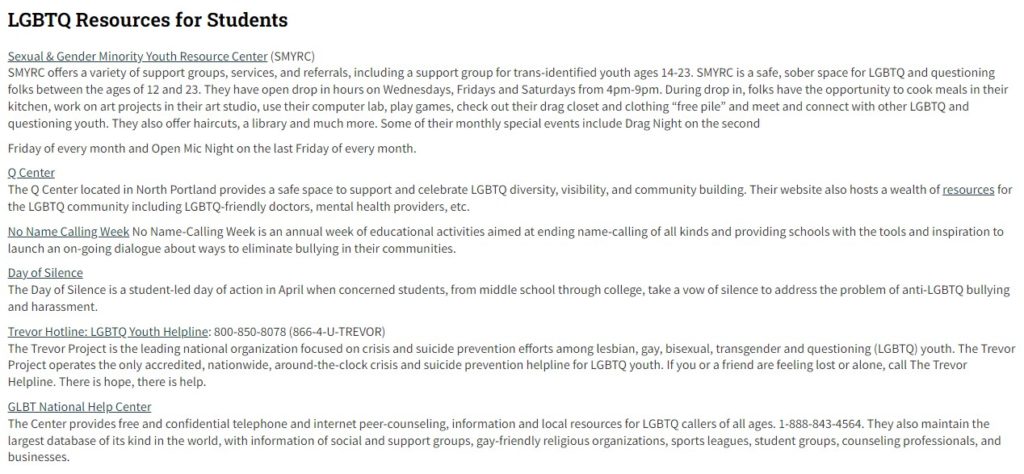
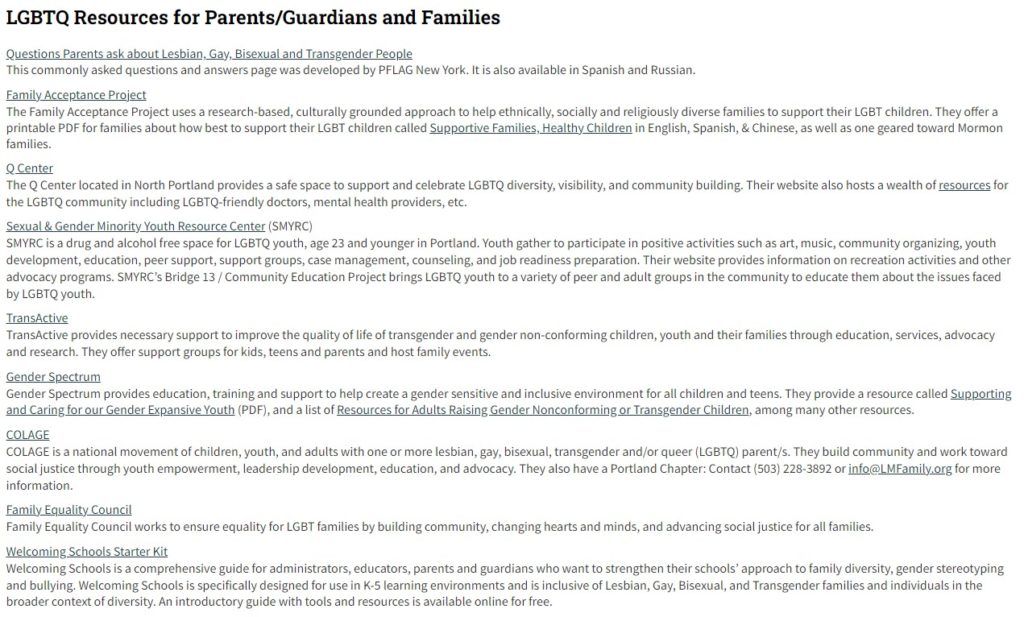
The school district provides resources to help educators craft lesson plans that implement “LGBTQ” themes. One resource is called “Unheard Voices: Stories and Lessons for Grades 6-12.” A document provided in the “Unheard Voices” resource includes lesson plans titled “The Invisibility of LGBT People in History,” “The History and Impact of Anti-LGBT Slurs,” “The Exclusion of LGBT People from Societal Institutions,” “Winning the Right to Marry: Historic Parallels,” and “Understanding Gender Identity.”
Portland Public Schools has a “Gender Diversity Support Guide” to “create a shared understanding about the ways in which the school will support transgender, nonbinary and gender diverse students.” The guide states that “regardless of whether a transgender or nonbinary student has legally changed their name or gender, students and staff should always use the pronoun and name with which the student identifies or requests.” The guide also states that “students shall be permitted to participate in gender-separated physical education, intramural athletics, and non-high school interscholastic athletics and activities in accordance with the student’s gender identity.” The guide also argues in favor of teaching young children about gender identity because “transgender and/or gender nonconforming children may express gender diversity as young as preschool.”
The school district provides resources for children who may be transitioning to another gender, including a “Student Name and/or Gender Change Form.” Students can change their first name in the “student information system.” Students can also have their gender changed in the “student information system” to options like “female, male, or nonbinary.”
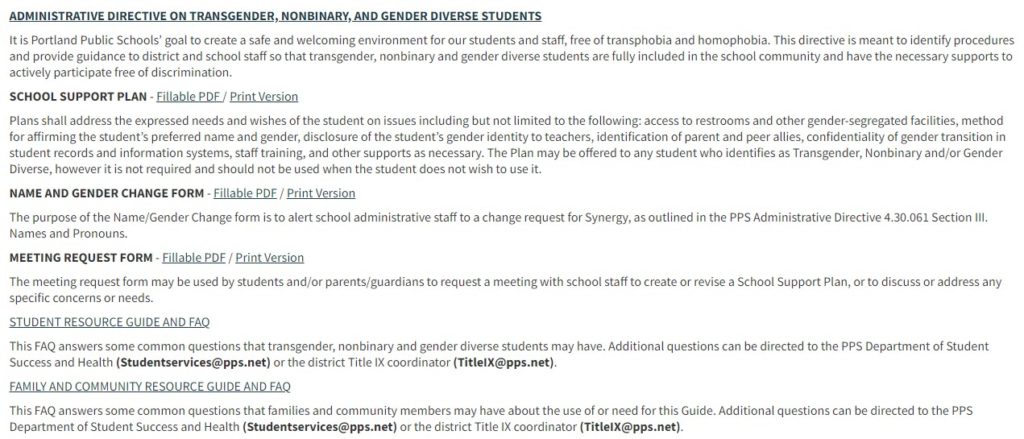
Stay Informed

